EB-2 & EB-3 Green Cards
You may be eligible for an EB-2 (employment-based, second preference) green card if you are a member of the professions holding an advanced degree or its equivalent, or a foreign national who has exceptional ability. To qualify under the advanced degree designation, the job you apply for must require an advanced degree (masters or higher) and you must possess such a degree or its equivalent (a baccalaureate degree plus 5 years progressive work experience in the field).
You may be eligible for an EB-3 (employment-based, third preference) green card if you are a Skilled Worker, Professional, or Other Worker.
- Skilled Workers are persons whose job requires a minimum of 2 years training or work experience, not of a temporary or seasonal nature
- Professionals are persons whose job requires at least a U.S. baccalaureate degree or a foreign equivalent and who are a member of the professions
- The Other Workers subcategory is for persons performing unskilled labor requiring less than 2 years training or experience, not of a temporary or seasonal nature.
Green Card Process
There are three steps to the Green Card process for EB-2 and EB-3 cases.
1. Testing of the U.S. Job Market
Both EB-2 and EB-3 green cards require an applicant to undergo the PERM process or Labor Certification, which is a testing of the U.S. job market. The purpose of the PERM process is for an employer to prove that a U.S. worker is unavailable for the offered position.
Effective March 28, 2005, the U.S. Department of Labor (DOL) implemented a procedure for applying for permanent labor certification – the Program Electronic Review Management process (PERM process). A permanent labor certification issued by the DOL allows an employer to hire a foreign worker to work permanently in the United States. This is a prerequisite of many employment-based green card petitions.
The PERM process requires the petitioning employer to conduct a series of recruitment activities to test the current U.S. job market before filing the application. If no qualified and willing U.S. worker (U.S. citizen or Permanent Resident) is found through the recruitment process, the employer can submit the PERM Labor Certification to the DOL.
An employer must run a recruitment campaign within 30-180 days before the filing of the PERM application. The employer is required to place:
- two print ads in a Sunday newspaper of general circulation;
- one ad in professional journal;
- one ad on employers internet site;
- one ad on job search web sites;
- one ad on state job bank for 30 days;
Advertisements cannot be tailored to an applicants background and must contain the general minimum requirements for the position. Applicants must be carefully screened and contacted if they meet the minimum requirements. A detailed recruitment report must be kept on file.
In addition, the Immigration and Nationality Act (INA) requires that the hiring of a foreign worker will not adversely affect the wages and working conditions of U.S. workers comparably employed. To comply with the statute, the Department’s regulations require that the wages offered to a foreign worker must meet the prevailing wage rate for the occupational classification in the area of employment. To confirm this figure, the employer is required to submit a request to the DOL for a Prevailing Wage Determination (PWD). The current processing timeline for the PWD is about 4 months.
Timeframe and costs for this step:
- Processing times: 3-6 months for the PWD/recruitment campaign + 9 months for DOL processing = 12-15 months (roughly).
- There is no charge for the filing of the PERM with the DOL.
- Costs for required advertising will vary according to the specific advertising source and location. An employer is required to pay these costs.
2. Filing a Form I-140 Immigrant Petition with USCIS
Once the PERM application is certified by the DOL, a a Form I-140 Immigrant Petition can be filed with U.S. Citizenship and Immigration Services (USCIS). Among other details, this petition requires proof of PERM certification, information about the employer (including its ability to pay the proffered wage to the applicant), evidence that the applicant holds a qualifying advanced or professional degree, and evidence that the applicant has gained specific skills required of the position.
Premium Processing service is available for EB-2/EB-3 Form I-140 petitions. Under the Premium Processing Service, USCIS guarantees petitioners that a government response will be issued within 15 calendar days of receipt.
Timeframe and costs for this step:
- Regular Processing: response on the petition in 6-12 months depending on government processing times (varies) and location of service center. USCIS filing fee of $700.00 is required.
- Premium Processing (optional): response on the petition in 15 business days with an additional fee.
3. Immigrant Visa Processing or Adjustment of Status
The final step of the green card process is asking the government to create the physical green card for the applicant based on the Form I-140 Immigrant Petition approval. There are two ways to do this. Adjustment of Status is a procedure that allows an applicant to become a lawful permanent resident without having to attend an immigrant visa interview outside the U.S. By contrast, with Immigrant Visa (Consular) Processing, the immigrant visa interview takes place at an Embassy or Consulate outside the U.S. that has jurisdiction over the beneficiary. Both methods of filing have advantages and disadvantages, and a decision should be made based on the applicant’s residence at the time of filing, status in the U.S., future travel and work plans, and the applicants preference for processing.
However, before either process can begin, it must be determined if a visa number is available. The U.S. has placed legal limits on the number of foreign nationals who may immigrate permanently each year. These limits apply to employment-based (EB), family based (FB) and diversity lottery categories (DV). The information needed to determine the availability of a visa number for a particular type of case can be found in the charts published in the Department of States Visa Bulletin each month. Berardi Immigration Law will assist in this complex analysis and confirm the filing strategy.
EB-2/EB-3 Related Posts
- EB-2 National Interest Waiver Green Cards
- DHS Final Rule Provides for Automatic 180 Extension of Work Authorization for Certain Categories when EAD Renewal Received
- FAQ October 2020 Visa Bulletin
- October 2020 Visa Bulletin Provides Significant Forward Movement for Employment-Based Adjustment of Status Applications
- What is PERM? An Overview of the PERM Process
- The PERM Difference: EB-2 and EB-3 Categories
- Foundation of the PERM Process: Skills & Business Necessity
- Determining a Prevailing Wage for PERM
- Navigating the PERM Recruitment Process
- PERM: Successor in Interest
Adjustment of Status
If the applicant has made a lawful entry into the U.S. and is currently residing in the U.S., he or she may be able to apply for Adjustment of Status (AOS). Applicants for AOS should take care to maintain lawful status in the U.S. throughout this process.
In this scenario, the paperwork relating to the foreign national’s eligibility to AOS is usually filed with USCIS at the same time the Form I-140 Immigrant Petition is submitted, unless the individual is subject to limitations with the visa bulletin as set forth above. Additionally, to establish employment eligibility and to preserve international travel privileges, other forms are also submitted with the application. Processing times for the AOS can vary from 6-12 months (subject to change) following the Form I-140 Immigrant Petition approval.
It is important to note that once an application for AOS has been filed, the applicant may not be able to depart the U.S. until travel authorization, also known as Advance Parole, is issued. In most cases, this document is usually issued within 3-5 months after the application has been submitted. Employment Authorization will also be issued at this time, allowing the foreign national to work in the U.S. while the application is pending. Should an applicant depart the U.S. while the application is pending but before Advance Parole is issued, USCIS may consider the applicant to have abandoned his or her application to adjust status. In certain situations, however, if the applicant is an H or L nonimmigrant maintaining valid status, he or she may be able to depart the U.S. prior to receiving Advance Parole without facing adverse consequences.
Immigrant Visa (Consular) Processing
If the applicant primarily resides abroad and meets certain statutory requirements, he or she may pursue Immigrant Visa Processing (IVP), also known as Consular Processing. Once the Form I-140 Immigrant Petition has been approved by the service center, USCIS will then send the case to the National Visa Center (NVC). The NVC is essentially the document-intake center for all embassies and consulates worldwide. Here, the applicant will be required to submit an additional application and documents for the NVC’s review. These items include biographic documentation of the applicant, including his/her birth certificate, police clearances, etc. Once the documentary requirements are met, the NVC will forward the application to the U.S. Embassy or Consulate having jurisdiction over the applicant’s place of birth. The Embassy/Consulate will then schedule the foreign national for his or her interview date along with instructions for undergoing a required medical examination. After the interview, the foreign national will receive an immigrant visa in his/her passport and can then enter the United States as a lawful permanent resident. The physical green card will follow by mail.
Immigrant Visa processing times range usually from 4-6 months after the Form I-140 petition approval, depending on Embassy or Consulate caseload. Please note that processing times are subject to change.
Once the green card is issued, the individual is now considered a lawful permanent resident and can reside and work in the U.S. on a permanent basis. Although this status is permanent, the actual card (Form I-551) expires every ten (10) years and must be renewed administratively by submitting a form and photos to USCIS.
Legal Services
Our office will confirm the legal fee for this three-step process. Our services include:
- Assistance in identifying the actual minimum requirements for the position(s);
- Submitting a request for the prevailing wage;
- Drafting and ordering the required advertisements;
- Providing guidance on the good faith recruitment and evaluation of applicants;
- Assisting with the preparation of the required recruitment report;
- Completing the PERM on-line application;
- Drafting and submitting the I-140 petition and supporting documentation; and
- Drafting the Adjustment of Status or Visa Processing documentation.
Green Card Video Posts
-
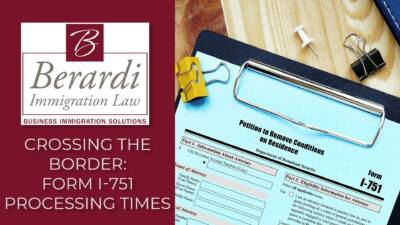
Crossing the Border: Form I-751 Processing Times
Conditional green cards are issued to foreign nationals who, at the time of filing a marriage-based green card, have been married to their U.S. citizen spouse for less than two years. A conditional green card is only valid for two years. To remove the conditions on residence and obtain a 10-year green card, you and […]Read More -

How to Replace a Stolen or Lost Green Card
Our office receives tons of frantic phone calls from Lawful Permanent Residents who lost their Permanent Resident Cards, more commonly known as Green Cards. A Green Card is an identity document that is proof of a Lawful Permanent Resident’s status, as well as their right to live and work in the United States. The good […]Read More -

3 Key Things to Consider Before Starting the PERM Process
The PERM green card process a time-consuming and expensive investment that requires thoughtful strategizing at the outset. Here are three things to consider before starting the PERM case. Watch our video below and for more info go to our PERM/Green Card Center. If you have any questions, contact Berardi Immigration Law today.Read More -
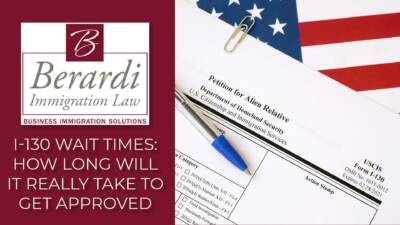
I-130 Processing Times
The top question we receive from individuals applying for family-based or marriage-based permanent residence in the U.S. is: How long will it take to get my green card? This answer will vary depending on the method that families and couples pursue to obtain this benefit as well as the category of relationship involved. Watch the […]Read More -

4 Things You Should Do at Your Immigration Interview
Berardi Immigration Law Associate Attorney Zach Ahlstrom talks about four things you must do at your immigration interview in the video below. Preparing for a marriage-based green card interview – we’ve got that on the Berardi Blog, too. If you have any questions, contact Berardi Immigration Law today.Read More -

Congratulations, You’re a U.S. Citizen!
Citizenship/naturalization is a permanent benefit with many privileges, including worry-free travel and the ability to participate in the US electoral process. The Form N-400, Naturalization Application is currently 20 pages long, and consists of complex biographic and travel questions. It is imperative that all information is accurately and properly completed to prevent delays in processing […]Read More -

Outline of the Marriage Based Green Card Process
Rosanna Berardi, Managing Partner of Berardi Immigration Law, goes into detail regarding the process of obtaining a green card for a foreign spouse once the couple is married.Read More -

U.S. Employment-Based Green Card Options
In this video, Senior Associate Attorney Gabriella Agostinelli goes into detail describing the options for U.S. employment based green cards. She outlines each option to help choose which may be best suited for an employee based on their experience and qualifications.Read More -
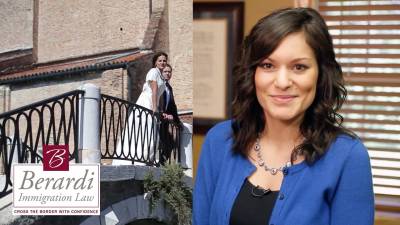
Marriage-Based Green Card Holders
Senior Associate Attorney Gabriella Agostinelli outlines important things to keep in mind if you have obtained a green card through marriage to a U.S. citizen. Gabriella also covers what to do to maintain your green card status and how you may qualify for U.S. citizenship.Read More -

Green Cards for Same Sex Marriage
Managing Partner Rosanna Berardi discusses the process of obtaining a marriage based green card for same-sex couples. Rosanna outlines the different paths which are available during this process and helpful information to remember about each.Read More -
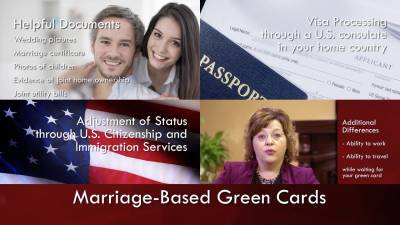
Marriage-Based Green Cards
In this video, Managing Partner Rosanna Berardi details the steps of the green card process, the different paths available, and how to ensure a successful outcome.Read More -
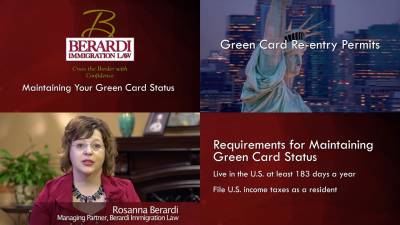
Maintaining Your Green Card Status
In this video, Managing Partner Rosanna Berardi goes through the requirements for maintaining green card status. Rosanna outlines the process of a re-entry permit and why you should consider this to help maintain your green card status if you cannot meet all green card requirements.Read More

